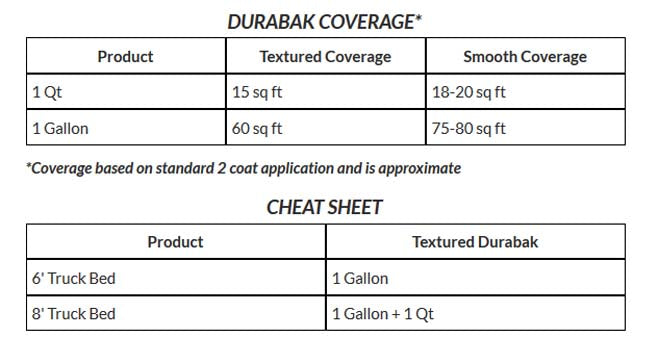We’ve shown you many ways to use Durabak – from
concrete patios to creating a
non-slip surface on horse trailers. Now it’s time to discuss bed liner used for undercoating. This is probably something you’ve never thought to do, but would be well worth your time.
Why Bed Liner Used for Undercoating
While the list of advantages could go on, here are a few of the best reasons to consider bed liner used for undercoating your chassis.
- Your undercarriage is protected from moisture and rust.
- It provides protection from snow and salt which destroy the underneath of vehicles.
- Protects from rock damage.
- Grease, dirt and other contaminants won’t stick to the bed liner.
- It looks nice.
- The chassis will be easy to clean.
It's important to note that the damage caused under the car builds up over time and often becomes unrepairable. Taking the step to undercoat your vehicle is a small and valuable investment in protecting your property.If you are sold on this project, let’s dive right into the steps you’ll need to know to complete the bed liner used for undercoating.
Steps to Protecting your Chassis with Bed Liner
Durabak is unique to your typical bed liner materials. It is textured with ground rubber so it offers durable protection against road debris. That’s why so many off-roaders have come to rave about the superior protection. If you are serious about protecting your chassis, you aren’t going to want to use just any bed liner product. Durabak is applied by spray, brush or roller; whatever is best for you. To work on the undercarriage, it seems to be best done with an undercoating gun, such as a Schutz spray gun.
Prep Work
The prep work to your job is the most important step. The cleaner your parts are, the longer your coating will last. Durabake adheres strongly to clean metal, so start with a wire wheel and clean all the old undercoating and dirt from the chassis’ sheet metal. If you need to make any rust repairs to floor pans or any other component, now is the time to do it. Before moving on with the bed liner, you’ll need to make sure that all your repairs are cured completely. Prior to applying Durabak, you’ll want to scrub all the surfaces with a heavy-duty cleaner and rags. Then, do it a second time with your rag and some mineral spirits. This helps you to remove any remaining grease that was missed after the first cleaning. It also removes any residue that was left over from the cleaner. Then, prepare your area properly to avoid getting bed liner on anything unnecessarily. You can also pour the needed amount of Durabak into a painter’s tray for easy application.
Application
Before applying Durabak, use 40-grit sandpaper or less to rough the surface. Then, wipe away the residue that is left. Then, apply a self-etching primer for metal on the chassis. Allow this to dry completely before proceeding further. Simply spray Durabak right onto the bare metal. When you reach the tight corners, try using the small chip brush for touch up work. Once the first coating is dry to the touch, you can finish with a second coat. As with any
spray on bed liner product, you’ll want to allow everything to dry completely before you head out on the road. This will prevent dirt and debris from being stuck in the wet bed liner material.
Final Say
Aside from bed liner use for undercoating, the possibilities with Durabak are endless. On top of that, the can will last you through many different projects. This high-quality product will continue to protect your investment for many years into the future. Don’t settle for any less than the best.

